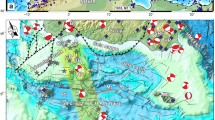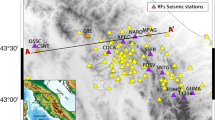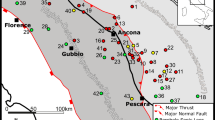Abstract
Large-scale deformation of continents remains poorly understood more than 40 years after the plate tectonic revolution1. Rock flow strength and mass density variations both contribute to stress, so both are certain to be important, but these depend (somewhat nebulously) on rock type, temperature and whether or not unbound water is present2. Hence, it is unclear precisely how Earth material properties translate to continental deformation zones ranging from tens to thousands of kilometres in width, why deforming zones are sometimes interspersed with non-deforming blocks and why large earthquakes occasionally rupture in otherwise stable continental interiors. An important clue comes from observations that mountain belts and rift zones cyclically form at the same locations despite separation across vast gulfs of time3 (dubbed the Wilson tectonic cycle), accompanied by inversion of extensional basins4 and reactivation of faults and other structures formed in previous deformation events5. Here we show that the abundance of crustal quartz, the weakest mineral in continental rocks2, may strongly condition continental temperature and deformation. We use EarthScope seismic receiver functions6, gravity and surface heat flow measurements7 to estimate thickness and seismic velocity ratio, vP/vS, of continental crust in the western United States. The ratio vP/vS is relatively insensitive to temperature but very sensitive to quartz abundance8,9. Our results demonstrate a surprising correlation of low crustal vP/vS with both higher lithospheric temperature and deformation of the Cordillera, the mountainous region of the western United States. The most plausible explanation for the relationship to temperature is a robust dynamical feedback, in which ductile strain first localizes in relatively weak, quartz-rich crust, and then initiates processes that promote advective warming, hydration and further weakening. The feedback mechanism proposed here would not only explain stationarity and spatial distributions of deformation, but also lend insight into the timing and distribution of thermal uplift10 and observations of deep-derived fluids in springs11.
This is a preview of subscription content, access via your institution
Access options
Subscribe to this journal
Receive 51 print issues and online access
$199.00 per year
only $3.90 per issue
Buy this article
- Purchase on Springer Link
- Instant access to full article PDF
Prices may be subject to local taxes which are calculated during checkout




Similar content being viewed by others
References
Williams, M. L. et al. Unlocking the secrets of the North American continent: an EarthScope science plan for 2010–2020. 〈http://www.earthscope.org/ESSP〉 (2010)
Bürgmann, R. & Dresen, G. Rheology of the lower crust and upper mantle: evidence from rock mechanics, geodesy and field observations. Annu. Rev. Earth Planet. Sci. 36, 531–567 (2008)
Wilson, J. T. Did the Atlantic close and then re-open? Nature 211, 676–681 (1966)
Ziegler, P. A. et al. Dynamics of intra-plate compressional deformation: the Alpine foreland and other examples. Tectonophysics 252, 7–59 (1995)
Sykes, L. R. Intraplate seismicity, reactivation of pre-existing zones of weakness, alkaline magmatism, and other tectonism postdating continental fragmentation. Rev. Geophys. 16, 621–688 (1978)
Crotwell, H. P. & Owens, T. J. Automated receiver function processing. Seismol. Res. Lett. 76, 702–709 (2005); data available at 〈http://www.iris.washington.edu/ears〉.
Blackwell, D. & Richards, M. Geothermal Map of North America, 2004 (scale 1:6,500,000, AAPG Item 423, 2004); data available at 〈http://smu.edu/geothermal〉.
Christensen, N. I. Poisson's ratio and crustal seismology. J. Geophys. Res. 101, 3139–3156 (1996)
Kono, Y., Miyake, A., Ishikawa, M. & Arima, M. Temperature derivatives of elastic wave velocities in plagioclase (An51±1) above and below the order-disorder transition temperature. Am. Mineral. 93, 558–564 (2008)
Roy, M., Jordan, T. H. & Pederson, J. Colorado Plateau magmatism and uplift by warming of heterogeneous lithosphere. Nature 459, 978–982 (2009)
Crossey, L. J. et al. Degassing of mantle-derived CO2 and He from springs in the southern Colorado Plateau region: neotectonic connections and implications for groundwater systems. Geol. Soc. Am. Bull. 121, 1034–1053 (2009)
Zhu, L. & Kanamori, H. Moho depth variation in Southern California from teleseismic receiver functions. J. Geophys. Res. 105, 2969–2980 (2000)
Smith, R. B. & Braile, L. W. The Yellowstone hotspot. J. Volcanol. Geotherm. Res. 61, 121–187 (1994)
Trehu, A. M. et al. Crustal architecture of the Cascadia fore-arc. Science 266, 237–243 (1994)
Godfrey, N. J. & Klemperer, S. L. Ophiolitic basement to a forearc basin and implications for continental growth: the Coast Range Great Valley ophiolite, California. Tectonics 17, 558–570 (1998)
Kistler, R. W. & Ross, D. C. A strontium isotopic study of plutons and associated rocks of the southern Sierra Nevada and vicinity, California. Bull. US Geol. Surv. 1920, 1–20 (1990)
Fleck, R. J. & Criss, R. E. Location, age, and tectonic significance of the Western Idaho Suture Zone (WISZ). US Geol. Surv. Open File Rep. 2004-1039, 1–48 (2004)
Kukkonen, I. T., Jokinen, J. & Seipold, U. Temperature and pressure dependencies of thermal transport properties of rocks: implications for uncertainties in thermal lithosphere models and new laboratory measurements of high-grade rocks in the central Fennoscandian Shield. Surv. Geophys. 20, 33–59 (1999)
Moschetti, M. P., Ritzwoller, M. H., Lin, F. & Lang, Y. Seismic evidence for widespread western-US deep-crustal deformation caused by extension. Nature 464, 885–889 (2010)
Sass, J. H. et al. Thermal regime of the southern Basin and Range Province 1. Heat-flow data from Arizona and the Mojave Desert of California and Nevada. J. Geophys. Res. 99, 22093–22119 (1994)
McKenzie, D. Some remarks on development of sedimentary basins. Earth Planet. Sci. Lett. 40, 25–32 (1978)
Molnar, P., England, P. & Martinod, J. Mantle dynamics, uplift of the Tibetan Plateau, and the Indian monsoon. Rev. Geophys. 31, 357–396 (1993)
Yardley, B. W. D. The role of water in the evolution of the continental crust. J. Geol. Soc. Lond. 166, 585–600 (2009)
Pérez-Gussinyé, M. et al. Effective elastic thickness of Africa and its relationship to other proxies for lithospheric structure and surface tectonics. Earth Planet. Sci. Lett. 287, 152–167 (2009)
Lowry, A. R., Ribe, N. M. & Smith, R. B. Dynamic elevation of the Cordillera, western United States. J. Geophys. Res. 105, 23371–23390 (2000)
Zandt, G. et al. Active foundering of a continental arc root beneath the southern Sierra Nevada in California. Nature 431, 41–46 (2004)
West, J. D., Fouch, M. J., Roth, J. B. & Elkins-Tanton, L. T. Vertical mantle flow associated with a lithospheric drip beneath the Great Basin. Nature Geosci. 2, 439–444 (2009)
Duval, J. S., Carson, J. M., Holman, P. B. & Darnley, A. G. Terrestrial radioactivity and gamma-ray exposure in the United States and Canada. US Geol. Surv. Open File Rep. 2005-1413, (2005); available at 〈http://pubs.usgs.gov/of/2005/1413/index.htm〉.
Kucks, R. P. Terrestrial radioactivity and gamma-ray exposure in the United States and Canada: Gridded geographic images. US Geol. Surv. Open File Rep. 2005-1413, (2005); available at 〈http://pubs.usgs.gov/of/2005/1413/datafiles.htm〉.
Davis, J. C. Statistics and Data Analysis in Geology 2nd edn (Wiley, 1986)
Grieser, J., Gommes, R., Cofield, S. & Bernardi, M. Data sources for FAO worldmaps of Koeppen climatologies and climatic net primary production. 〈http://www.fao.org/nr/climpag/globgrids/KC_commondata_en.asp〉 (2006)
Seipold, U. Temperature dependence of thermal transport properties of crystalline rocks — a general law. Tectonophysics 291, 161–171 (1998)
Bouhifd, M. A., Andrault, D., Fiquet, G. & Richet, P. Thermal expansion of forsterite up to the melting point. Geophys. Res. Lett. 23, 1143–1146 (1996)
Turcotte, D. L. & Schubert, G. Geodynamics 2nd edn (Cambridge Univ. Press, 2002)
Mareschal, J. C., Cunningham, J. P. & Lowell, R. P. Downward continuation of heat flow data: method and examples from the western United States. Geophysics 50, 846–851 (1985)
Christensen, N. I. & Mooney, W. D. Seismic velocity structure and composition of the continental crust: a global view. J. Geophys. Res. 100, 9761–9788 (1995)
Heard, H. C. & Page, L. Elastic moduli, thermal expansion and inferred permeability of two granites to 350 °C and 55 megapascals. J. Geophys. Res. 87, 9340–9348 (1982)
Afonso, J. C., Ranalli, G. & Fernàndez, M. Thermal expansivity and elastic properties of the lithospheric mantle: results from mineral physics of composites. Phys. Earth Planet. Inter. 149, 279–306 (2005)
Pollack, H. N. On the use of the volumetric thermal expansion coefficient in models of ocean floor topography. Tectonophysics 64, T45–T47 (1980)
Korenaga, J. Effective thermal expansivity of Maxwellian ocean lithosphere. Earth Planet. Sci. Lett. 257, 343–349 (2007)
Erkan, K. & Blackwell, D. Transient thermal regimes in the Sierra Nevada and Baja California extinct outer arcs following the cessation of Farallon subduction. J. Geophys. Res. 114 10.1029/2007JB005498 (2009)
Dziewonski, A. M. & Anderson, D. L. Preliminary Reference Earth Model. Phys. Earth Planet. Inter. 25, 297–356 (1981)
DeNosaquo, K. R., Smith, R. B. & Lowry, A. R. Density and lithospheric strength models of the Yellowstone-Snake River Plain volcanic system from gravity and heat flow data. J. Volcanol. Geotherm. Res. 188, 108–127 (2009)
Yuan, H. Y., Dueker, K. & Stachnik, J. Crustal structure and thickness along the Yellowstone hot spot track: evidence for lower crustal outflow from beneath the eastern Snake River Plain. Geochem. Geophys. Geosyst. 11 10.1029/2009GC002787 (2010)
Beck, J. V. & Arnold, K. J. Parameter Estimation in Engineering and Science (Wiley, 1977)
Acknowledgements
We thank K. Dueker, G. Pavlis, T. Ravat, J. Shervais and D. Schutt for discussions, and A. Braathen and R. Bürgmann for comments. We are grateful to P. Crotwell, T. Owens and members of IRIS for their efforts on the EARS database, and to P. Crotwell and B. Kucks for help with data acquisition. The work of A.R.L. on this project was supported by National Science Foundation grants EAR-0454541 (EarthScope Science: Rio Grande Rift) and EAR-0955909 (Geophysics/EarthScope CAREER: Deformation Processes), and by a Utah State University New Faculty Research Grant.
Author information
Authors and Affiliations
Contributions
A.R.L. developed and implemented the joint receiver function/gravity/heatflow inversion for crustal thickness and vP/vS. M.P.-G. developed and implemented the inversion for effective elastic thickness. The manuscript was written by A.R.L with contributions from M.P.-G.
Corresponding author
Ethics declarations
Competing interests
The authors declare no competing financial interests.
Supplementary information
Supplementary Figures
The file contains Supplementary Figures 1-6 with legends. (PDF 1431 kb)
Rights and permissions
About this article
Cite this article
Lowry, A., Pérez-Gussinyé, M. The role of crustal quartz in controlling Cordilleran deformation. Nature 471, 353–357 (2011). https://doi.org/10.1038/nature09912
Received:
Accepted:
Published:
Issue Date:
DOI: https://doi.org/10.1038/nature09912
This article is cited by
-
High-resolution Moho depth and Vp/Vs ratio distributions in northeast China from joint inversion of receiver functions and gravity data and their geological implications
Science China Earth Sciences (2023)
-
The influence of variations in crustal composition and lithospheric strength on the evolution of deformation processes in the southern Central Andes: insights from geodynamic models
International Journal of Earth Sciences (2021)
-
Discontinuous precipitation of rutilated quartz: grain-boundary migration induced by changes to the equilibrium solubility of Ti in quartz
Contributions to Mineralogy and Petrology (2020)
-
An updated stress map of the continental United States reveals heterogeneous intraplate stress
Nature Geoscience (2018)
-
Gravitational body forces focus North American intraplate earthquakes
Nature Communications (2017)
Comments
By submitting a comment you agree to abide by our Terms and Community Guidelines. If you find something abusive or that does not comply with our terms or guidelines please flag it as inappropriate.



